As autumn settles across North America, one hallmark of the season is the gentle southward flight of the Monarch Butterflies as they migrate towards the forests that shelter their species during the winter months. Unfortunately, as with other forests across the planet, the Monarch’s “over- wintering grounds” in Mexico are suffering from increased human pressures. An innovative conservation group called the ECOLIFE Foundation has stepped up to help safeguard the Monarch’s winter forests, and in the process discovered that addressing the Monarch’s plight came only after uncovering connections that bind us all. The following article is an interview with Bill Toone, the Executive Director of ECOLIFE.
Mongabay: Tell our readers about the development of the ECOLIFE Foundation and how your group decided to work with the over-wintering grounds of the Monarch Butterfly in the Sierra Madre Mountains of Mexico.
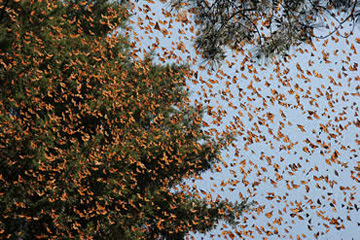 Monarch butterflies fill the sky. |
Bill Toone: The ECOLIFE Foundation was born in part out of a sense of frustration and a need for change in the global conservation community. By the time I decided to help start ECOLIFE, I had spent 38 years working in conservation and one of the things that frustrated me about this field was that conservation work always seemed to be done in conflict with people. Although there were other groups stepping up with “community based conservation projects,” this practice generally amounted to hiring a handful of local people as guides, rangers, “bio surveyors,” etc. These people were often placed in conflict with their local communities. In other words they were really hired as guards to protect local natural resources from the local communities.
Solidifying my belief in the need for a “human element” in conservation came in the year 2000. In that year, I experienced both a professional and personal disaster in Madagascar where I lost a number of friends in a local village that had been hit by a catastrophic storm. When I went back to the various conservation groups that had supported my field work to help these local people, they generally declined because it was not perceived as a “conservation issue.”
I thought this was very short-sighted and so it became our philosophy at ECOLIFE that conservation had to find a way to integrate itself into everyone’s lives and that our work was not to be developed at the expense of local people. For conservation to be sustainable, it has to be approached differently, and not as altruism imposed by the developed world on those in developing areas.
The decision to work with Monarch Butterflies was both a personal and professional choice. The species wintering grounds is a personal and sentimental favorite: one of my first dates with my wife was to see the over-wintering grounds of the Monarchs. Through my extended travels and decades of conservation work I have had the opportunity to see a lot of the planet’s great wild places, and the Monarch’s forest in winter is truly among the most spectacular. Working with the Monarch Butterflies fit ECOLIFE’s organizational goals as well: it was a charismatic species with an ongoing human conflict over the forest resources of the Sierra Madre Mountains in Mexico.
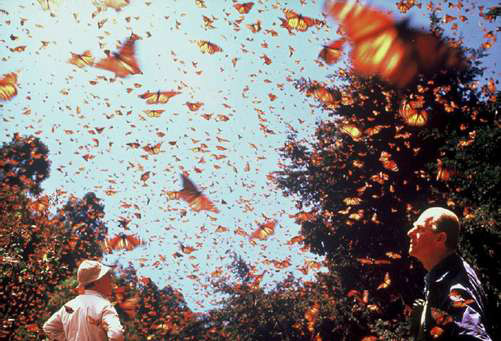
“One of the great spectacles of the natural world.” Photo Courtesy of UNESCO.
Mongabay:
What are the greatest threats that Monarchs face today?
Bill Toone: Monarch butterflies face multiple threats and though the species seems wide-spread and common, Monarch Butterflies have been under increased pressures. When I look back to my first visits to the Monarch wintering grounds in Mexico some twenty five years ago to today, the number of butterflies has declined by more then 50 percent.
The threats Monarchs face are many, but the biggest problem is deforestation of the over-wintering grounds. The reason this is more critical than the increasing threat of pesticides in the US or the decline of milkweed in North America (a plant species on which Monarchs rely), is that you literally have the entire Eastern population of butterflies in one place at one time. As a result, impact in these over-wintering grounds can have continent-wide implications for the Monarchs.
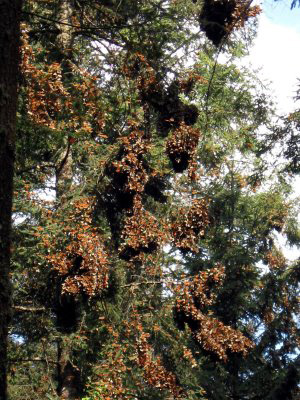 “The Monarchs at their over-wintering forests”. Photo Courtesy of the US Fish and Wildlife Service. |
There are two primary reasons for the loss of this forest: First, there is an organized, illegal logging cartel operating in the Sierra Madre that is literally stealing logs from the Monarch sanctuaries and from the indigenous people or “Ejido,” who also depend upon these forests. Secondly, there is enormous demand for fuel wood locally, each year a quarter million trees from the area of the butterfly reserves have been used for cooking and heating homes.
Mongabay:
Please tell our readers about the “ECOLIFE Efficient Stoves Program.”
Bill Toone: We chose to look at the heart of the perceived conflict between man and butterfly and found a problem more complex then initially thought. The local people around the Monarch forests were using traditional indoor cooking stoves that were both inefficient and a source of many health hazards. These local stoves consisted of three stones placed in the shape of a “U” where a grill is placed on top for cooking. Though these stoves are indoors, there is no chimney, and local homes are built in what appears to be a rickety manner, with gaps throughout. This is done intentionally in an attempt to vent smoke. But this is rather ineffective in dealing with this smoke, is very inefficient heat wise, and you can literally scrape the tar off the ceilings in most of these homes. One of the few things people realize is that globally 1.6 million women and children die every year from the hazardous effects of indoor cooking fires. Traditional indoor stoves have created a problem for both the local people and the Monarch Butterflies.
Thinking of the problem as one that was related to the use of wood, we started working with a local group in Mexico that had designed an enclosed stove with a chimney. This chimney alone reduced respiratory ailments by over 40 percent in local families and virtually eliminated childhood burns. And by enclosing the firebox, this stove reduced fuel use by 70 percent.
We have been asked “why don’t you give them solar stoves?” These types of stoves won’t offer the type of cooking that is intrinsic to local culture. Wood-fire taste and cooking is part of local flavor and the goal of our program was to create a stove that allowed them to use wood in a more efficient way.
Mongabay:
Your group has placed a strong emphasis on working with the local people of the Sierra Madre through the “efficient stove program.” Tell us about the challenges of this outreach work.
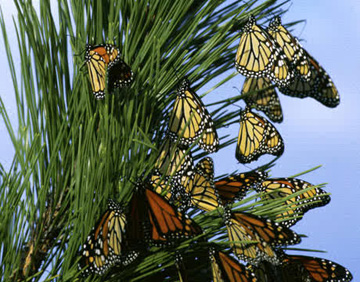  250 Million Monarch Butterflies over-winter in the Sierra Madre. Photos Courtesy of the US Fish and Wildlife Service. |
Bill Toone: At first, the challenges were absolutely enormous, and this was probably the most important learning experience that our project faced. The very first stoves that we built were not well received by the locals. In spite of the fact that these stoves were designed and built in the area, we were not addressing perceived local needs in our outreach efforts. The first stoves were met very politely within the local communities. When we asked if we could give families a stove that helps save the butterflies, everyone smiled and said they would participate. We would make arrangements to give local families stoves, but as soon as they were installed, these same families would dismantle our stoves and throw them away. (In all fairness how would we feel if an outside group came into our kitchens and told us how we were going to cook going forward?)
We were pretty discouraged by the local disinterest, but soon realized that we had strayed from a core value of addressing the local people’s needs.
We turned our approach around and related how the program and stoves could help their families: that these stoves would make their lungs feel better, protect their children from burns, and that their husbands wouldn’t have to spend as much time away from home collecting wood. By addressing local concerns, our stove builders have gone from a group who no one cared about to literally “local rock stars.” They can’t drive through a community without being chased by women who want stoves for their homes!
The key to successfully developing this program was valuing what is important to each and every one of us: our health and the well being of our families. The minute we focused on these types of needs, we found common ground, and now we cannot build stoves fast enough per the demand.
Mongabay:
In the eyes of the locals, how do you connect a stove with a butterfly?
Bill Toone: When we first started our outreach program all the stoves had a hand-painted tile on them with a picture of a Monarch Butterfly which stated “Mi llamo Patsari”…”My name is Patsari and I am a friend of the Butterfly.” When we shifted the outreach focus to discussions of local health, we thought we could save money by removing the tiles from these stoves. The locals nearly rioted. They loved the tiles and had begun to view the butterflies as a symbol of their forests and in a true sense view the Monarch Butterflies as community benefactors. Mutual interest in the forests on the part of conservation groups and local peoples created a bridge which led to ideas that were beneficial for both humans and Monarch Butterflies.
Growing local interest and pride in the Monarchs has had broader implications as well. Local government tolerance for cartel logging interests has collapsed, and the Government of Mexico is now taking an aggressive stand against these illegal logging operations. Forest loss in the Monarch Butterfly sanctuaries was down by 97 percent this year. Many of Mexico’s leading government officials are from the State of Michoacan, site of the Butterfly Reserves, and these officials now have a vested stake in forests that are valued by both local people and the global community. In 2008, the Monarch Butterfly Reserves were designated as a UNESCO World Heritage Site which has increased these forests standings on both a local and global basis.
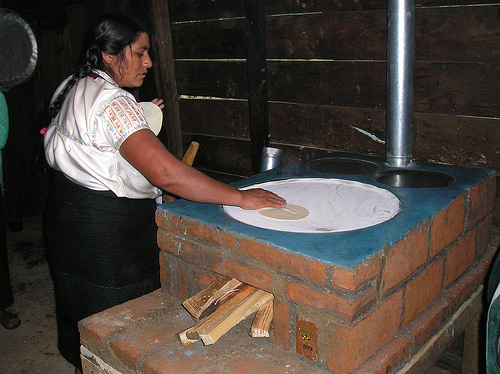
“Mi llamo Patsari”. Photo Courstesy of Patsari,org. Patsari Stoves: With every $120 dollar donation, ECOLIFE builds and installs a highly efficient wood burning Patsari stove for use in the homes of the Ejido communities. An average Ejido family requires 40 trees annually for heating and cooking. The Patsari stove reduces this to 12 trees.
Mongabay:
What are next steps for ECOLIFE’s Monarch Butterfly program? Are there thoughts for increased public outreach in regard to the Monarch Butterfly?
 ECOLIFE “Building Connections”. Also see: CBS Evening News Video: “Saving the Monarchs” |
Bill Toone: During the course of their annual migration, the Monarch Butterflies travel across three countries: Canada, the United States, and Mexico. This species provides an opportunity for three countries to come together on a common conservation issue. The Monarch is an important pollinator of crops in North America, at a time when bee populations have struggled with collapse and these butterflies are simply among the world’s most beautiful. The Monarch Butterfly, with its amazing annual migration, represents a tangible symbol that people across various countries and communities have a very real connection in nature and that we all have a shared interest in working together to conserve the environment.
Going forward, ECOLIFE will continue to focus on community education and outreach with the local people of the State of Michoacan to further the bridge between the local communities, the area’s forests, and the Monarch Butterfly. And we will work with other conservation groups in North America to help safeguard Monarchs across this vast range.
Though the Monarch Butterfly program is just one of ECOLIFE’s global projects, our work with this species reinforced a core belief that conservation needs to be inclusive. Everyone across the planet really has a shared, vested stake in the outcome.
Related articles
Monarch butterflies medicate their sick kids
(10/12/2010) A new study in Ecology Letters has discovered that monarch butterflies employ medicinal plants to treat their larva. Researchers found that certain species of milkweed, which the larva feed on, can reduce the threat of a sometime deadly parasite. However, even more surprising: “we have also found that infected female butterflies prefer to lay their eggs on plants that will make their offspring less sick, suggesting that monarchs have evolved the ability to medicate their offspring,” says lead author Jaap de Roode.
Uncovering the intelligence of insects, an interview with Lars Chittka
(06/29/2010) Many people would likely consider ‘insect intelligence’ a contradiction in terms, viewing insects—when they think of them as anything more than pests—as something like hardwired tiny robots, not adaptive, not intelligent, and certainly not conscious. However, research over the last few decades have shown that a number of well-studied insects are capable of performing amazing intellectual feats, from recognizing individuals to employing a symbolic language in a behavior known as a ‘bee waggle’. “Already in 1900, Buttel-Reepen asked whether honeybees are mere reflex machines—and emphatically denied that claim,” Dr. Lars Chittka, professor of Sensory and Behavioral Ecology at Queen Mary University in London, told mongabay.com in an interview. “Over the last century, we have seen a fundamental change in perspective on the learning capacities of insects, and there a now several credible lines of evidence that insects are capable of cognitive feats that had previously been ascribed only to ‘higher’ vertebrates”.
Sophisticated flying methods allow insects to hitchhike on fast winds
(02/04/2010) Researchers have long been fascinated by how insects migrate thousands of kilometers, for example from Britain to the Mediterranean. A new study, published in Science shows that although tiny, insects are not at the mercy of winds as expected. Instead they employ sophisticated flight behaviors to use fast winds to their advantage.
First comprehensive study of insect endangerment: ten percent of dragonflies threatened

(06/23/2009) A lot of time, effort, and funds have been spent on programs evaluating the threat of extinction to species around the world. Yet insects have not benefited from these programs, which have largely focused on more ‘charismatic’ species such as mammals, birds, amphibians, and reptiles. This gap is clearly shown by the fact that 42 percent of vertebrates have been assessed by the International Union for the Conservation of Nature (IUCN), and only 0.3 percent of invertebrates.
Photo: brilliant pink moth discovered in Arizona
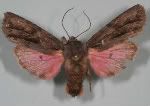
(06/11/2009) A new species of moth with brilliantly-colored pink wings has been discovered at 7,700 feet in the Chiricahua Mountains of southern Arizona. “This large moth flew in and we didn’t think much of it because there is a silk moth very much like it, a Doris silk moth that feeds on pines that has dark wings with pink on the hind wings. It’s fairly common there,” said University of Arizona biologist, Bruce Walsh, who discovered the species.
Butterfly tricks ants by mimicking their queen’s vocalizations
(02/05/2009) With cohesive hierarchical societies and a number of communication techniques, ants have been able to conquer a wide variety of ecosystems with great success. However, according to a recent paper in Science ants’ highly structured society at times comes with a price. A number of insects have evolved means to covertly infiltrate the ants’ society and live off their work and bounty by closely mimicking various ant communication methods. While scientists believe that these parasitical insects largely mimic ant communications like chemical exchange and physical contact—such as touching antennae—the study, however, discovered a butterfly which succeeds in infiltrating the highest echelons of ant society by vocalizing like a queen.
